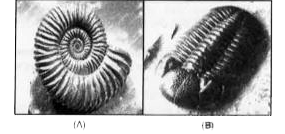Complete Solutions to TOPIC - 2 (ORIGIN OF LIFE AND EVOLUTION)(SHORT ANSWER TYPE QUESTIONS - II) of chapter HEREDITY AND EVOLUTION of Class 10 book with complete answers and questions
| Class 10 | BIOLOGY |
| Chapter | HEREDITY AND EVOLUTION |
| OSWAAL PUBLICATION | TOPIC - 2 (ORIGIN OF LIFE AND EVOLUTION)(SHORT ANSWER TYPE QUESTIONS - II) |
| Number Of Questions | 24 |
| Academic Year | 2023-24 |
(i) What are fossils? How do we know how old the fossils are?
(ii) State two differences between homologous and analogous organs.03:51View SolutionWhy are the small numbers of surviving tigers a cause of worry from the point of view of genetics?
02:09View SolutionA palaeontologist observes the jaw of an animal and concludes that it belong to mammals. Give reason for his conclusion.
01:24View SolutionDifferentiate between Caucasoid man and Mongoloid man based on their physical features.
01:06View Solution
(a) Identify the fossils A and B?
(b) What type of fossils are these?01:11View SolutionWhat is speciation? Explain in brief the role of natural selection and genetic drift in this process.
03:20View SolutionExplain the terms
(i) Speciation (ii) Natural selection01:50View SolutionDefine the following with one example for each :
(i) Genetic Drift.
(ii) Natural selection.
(iii) Reproductive isolation.04:09View SolutionName three organisms which are fossilized.
01:02View Solution(i) Which of the following fossils is invertebrate and which one is vertebrate?
(a) Dinosaur, (b) Ammonite.
(ii) How can the age of fossil be ascertained? State in brief any two methods.01:53View SolutionGive two uses of fossils. How does the study of fossils provide evidence in favour of organic evolution?
03:14View SolutionWhen organisms die, their bodies will decompose and be lost. Then how do we get fossils? Give an example.
02:32View SolutionHow were farmers able to obtain present day cabbage, cauliflower and broccoli from wild cabbage?
02:27View Solution"Evolution should not be equated with progress". Why?
01:12View SolutionList three factors that provide evidences in favour of evolution in organisms and state the role of each in brief.
02:49View SolutionHomologous organs are different form analogous organs.
(i) Mention the two basic characteristics that decide about analogy and homology between the two organs.
(ii) On what basis is the classification of organisms into prokaryotic and eukaryotic done?02:38View SolutionThere are two different types of organs, homologous and analogous. Differentiate between them by giving three points.
02:24View SolutionAll human races like Africans, Asians, Europeans, Americans and others look so different from each other still they belong to the same species. Give three points to justify the statement.
02:06View SolutionList three factors that provide evidences in favour of evolution in organisms and state the role of each in brief.
02:49View Solution(i) Planaria, insects, octopus and vertebrates all have eyes. Can we group eyes of these animals together to establish a common evolutionary origin? Justify your answer.
(ii) "Birds have evolved from reptiles". State evidence to prove the statement.03:34View Solution"It is a matter of chance whether a couple will have a male or a female child." Justify this statement by drawing a flowchart.
03:59View Solution(a) Cite the evidence on the basis of which it is concluded that birds have evolved from reptiles.
(b) Insects, Octopus, Planaria and Vertebrates also possess eyes. Can these animals be grouped together on the basis of the eyes they possess. Why or why not? Give reason to justify your answer.03:52View SolutionThe modern human beings have originated in Africa.
(i) Which evidence suggests this fact?
(ii) If an animal is similar to its ancestors, what does this imply?03:16View Solution(i) A husband has 46 chromosomes, his wife has 46 chromosomes. Then why don't their offsprings have 46 pairs of chromosomes, which is obtained by the fusion of male and female gametes?
(ii) "Geographical isolation is not a major factor in the speciation of a self pollinating plant species." Justify this statement with the help of an example.04:18View Solution
TOPIC - 2 (ORIGIN OF LIFE AND EVOLUTION)(SHORT ANSWER TYPE QUESTIONS - II) questions and complete solutions for chapter HEREDITY AND EVOLUTION of OSWAAL BIOLOGY (KANNADA ENGLISH) of Class 10
All Exercises from OSWAAL PUBLICATION Class 10 BIOLOGY HEREDITY AND EVOLUTION
- NCERT CORNER TEXTBOOK EXERCISES
- NCERT CORNER (INTEXT QUESTIONS)
- TOPIC - 1 (HEREDITY AND MENDEL.S CONTRIBUTION)(LONG ANSWER TYPE QUESTIONS)
- TOPIC - 1 (HEREDITY AND MENDEL.S CONTRIBUTION)(MATCH THE COLUMN)
- TOPIC - 1 (HEREDITY AND MENDEL.S CONTRIBUTION)(MULTIPLE CHOICE QUESTIONS)
- TOPIC - 1 (HEREDITY AND MENDEL.S CONTRIBUTION)(SHORT ANSWER TYPE QUESTIONS - I)
- TOPIC - 1 (HEREDITY AND MENDEL.S CONTRIBUTION)(SHORT ANSWER TYPE QUESTIONS - II)
- TOPIC - 1 (HEREDITY AND MENDEL.S CONTRIBUTION)(VERY SHORT ANSWER TYPE QUESTIONS)
- TOPIC - 2 (ORIGIN OF LIFE AND EVOLUTION)(LONG ANSWER TYPE QUESTIONS)
- TOPIC - 2 (ORIGIN OF LIFE AND EVOLUTION)(MATCH THE COLUMN)
- TOPIC - 2 (ORIGIN OF LIFE AND EVOLUTION)(MULTIPLE CHOICE QUESTION)
- TOPIC - 2 (ORIGIN OF LIFE AND EVOLUTION)(SHORT ANSWER TYPE QUESTIONS - I)
- TOPIC - 2 (ORIGIN OF LIFE AND EVOLUTION)(SHORT ANSWER TYPE QUESTIONS - II)
- TOPIC - 2 (ORIGIN OF LIFE AND EVOLUTION)(VERY SHORT ANSWER TYPE QUESTIONS)
